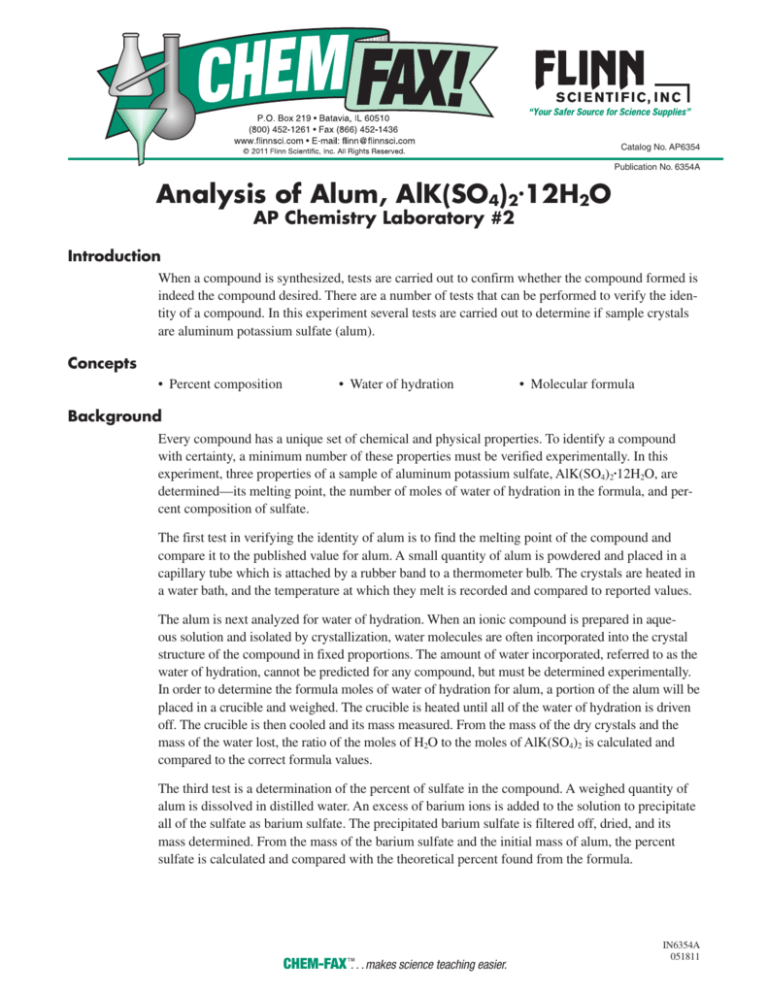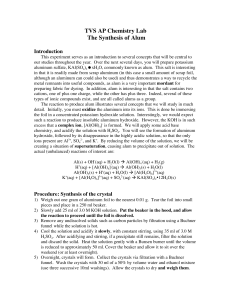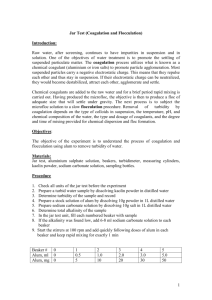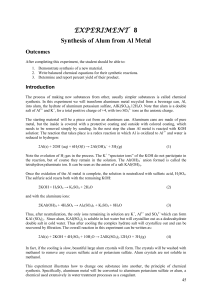
Catalog No. AP6354
Publication No. 6354A
Analysis of Alum, AlK(SO4)212H2O
AP Chemistry Laboratory #2
Introduction
When a compound is synthesized, tests are carried out to confirm whether the compound formed is
indeed the compound desired. There are a number of tests that can be performed to verify the identity of a compound. In this experiment several tests are carried out to determine if sample crystals
are aluminum potassium sulfate (alum).
Concepts
• Percent composition
• Water of hydration
• Molecular formula
Background
Every compound has a unique set of chemical and physical properties. To identify a compound
with certainty, a minimum number of these properties must be verified experimentally. In this
experiment, three properties of a sample of aluminum potassium sulfate, AlK(SO4)212H2O, are
determined—its melting point, the number of moles of water of hydration in the formula, and percent composition of sulfate.
The first test in verifying the identity of alum is to find the melting point of the compound and
compare it to the published value for alum. A small quantity of alum is powdered and placed in a
capillary tube which is attached by a rubber band to a thermometer bulb. The crystals are heated in
a water bath, and the temperature at which they melt is recorded and compared to reported values.
The alum is next analyzed for water of hydration. When an ionic compound is prepared in aqueous solution and isolated by crystallization, water molecules are often incorporated into the crystal
structure of the compound in fixed proportions. The amount of water incorporated, referred to as the
water of hydration, cannot be predicted for any compound, but must be determined experimentally.
In order to determine the formula moles of water of hydration for alum, a portion of the alum will be
placed in a crucible and weighed. The crucible is heated until all of the water of hydration is driven
off. The crucible is then cooled and its mass measured. From the mass of the dry crystals and the
mass of the water lost, the ratio of the moles of H2O to the moles of AlK(SO4)2 is calculated and
compared to the correct formula values.
The third test is a determination of the percent of sulfate in the compound. A weighed quantity of
alum is dissolved in distilled water. An excess of barium ions is added to the solution to precipitate
all of the sulfate as barium sulfate. The precipitated barium sulfate is filtered off, dried, and its
mass determined. From the mass of the barium sulfate and the initial mass of alum, the percent
sulfate is calculated and compared with the theoretical percent found from the formula.
CHEM-FAX. . .makes science teaching easier.
IN6354A
051811
Analysis of Alum, AlK(SO4)2 12H2O
Page 2
Experiment Overview
The purpose of the experiment is to analyze alum, AlK(SO4)212H2O, by three techniques in
order to verify its identity. The following properties will be determined—melting point, mole
ratio of hydrated water to anhydrous potassium aluminum sulfate, and percent of sulfate ion contained in the compound. Each of these properties will be compared to the literature or calculated
values for alum.
Pre-Lab Questions
1. When measuring a melting point, why is it necessary to raise the temperature very slowly
when approaching the melting temperature?
2. Washing soda is a hydrated compound whose formula can be written Na2CO3xH2O, where x is
the number of moles of H2O per mole of Na2CO3. When a 2.123 g sample of washing soda was
heated at 130 °C, all of the water of hydration was lost, leaving 0.787 g of anhydrous sodium
carbonate. Calculate the value of x.
3. The formula for epsom salts is MgSO47H2O. If 1.250 g of the compound is dissolved in water,
calculate the number of milliliters of 0.200 M Ba(NO3)2 that would be required to precipitate
all of the sulfate ions as barium sulfate.
Make the same determination for 1.000 g of alum.
Materials
Part 1
Aluminum potassium sulfate, AlK(SO4)212H2O, 0.5 g
Beaker, 150-mL (or Thiele melting point tube)
Bunsen burner
Hot plate
Capillary tube
Split stopper to hold thermometer
Mortar and pestle
Ring stand, ring, and wire gauze
Rubber band
Thermometer, 0 °C–100 °C
Universal clamp
Part 2
Aluminum potassium sulfate, 2 g
Balance, 0.001-g precision
Bunsen burner
Crucible and cover
Ring stand, ring support
Triangle, pipe stem
Wire gauze
Part 3
Aluminum potassium sulfate, 1 g
Barium nitrate solution, Ba(NO3)2, 0.2 M, 50 mL
Balance, 0.001-g precision
Beaker, 250-mL
Beaker, 400-mL
Bunsen burner (or hot plate)
Drying oven
Filter funnel and fine-grained, quantitative, filter paper
Graduated cylinder, 50-mL
Graduated cylinder, 10-mL
Hot plate
Ring stand, ring
Rubber policeman
Stirring rod
Thermometer, 0 °C–100 °C
Wash bottle with distilled water
Watch glass
© 2011 Flinn Scientific, Inc. All Rights Reserved. Reproduction permission is granted only to science teachers who have purchased Analysis of Alum, AlK(SO4)212H2O, Catalog No. AP6354, from
Flinn Scientific, Inc. No part of this material may be reproduced or transmitted in any form or by any means, electronic or mechanical, including, but not limited to photocopy, recording, or any information storage and retrieval system, without permission in writing from Flinn Scientific, Inc.
Analysis of Alum, AlK(SO4)2 12H2O
Page 3
Safety Precautions
Barium nitrate solution is toxic by ingestion. Wear chemical splash goggles, chemical-resistant
gloves, and a chemical-resistant apron. Thoroughly wash hands with soap and water before leaving the laboratory.
Procedure
Part 1. Melting Point Determination of Alum
1. Using a mortar and pestle, pulverize a small amount (about 0.5 g) of dry alum.
2. Pack the alum in a capillary tube to a depth of about 0.5 cm. To get the alum into the capillary
tube, push the open end of the capillary tube down into a small pile of alum powder.
3. To pack the alum tightly at the closed end of the capillary tube, turn the tube so the open end is
up, and bounce the bottom of the tube on the desk top.
4. Fasten the capillary tube to a thermometer with a rubber band. The alum should be level with
the thermometer bulb (see Figure 1).
Thermometer
Capillary tube
Sample in tube
Experimental Setup
Figure 1.
5. Using a universal clamp and cork stopper (or split rubber stopper), fasten the thermometer to a
ring stand.
6. Immerse the bottom of the capillary and thermometer in a beaker of water (or a Thiele melting
point tube filled with water) and heat (see Figure 2). If using a beaker, stir the water to maintain
an even distribution of temperature. The water bath may be heated rapidly in the beginning, but
as the temperature approaches the melting point of alum, the water bath should be heated more
slowly in order to get an accurate temperature reading of the melting point.
7. Record the temperature range at which the alum melts (the white powder will turn to a colorless liquid) in the Part 1 Data Table.
© 2011 Flinn Scientific, Inc. All Rights Reserved. Reproduction permission is granted only to science teachers who have purchased Analysis of Alum, AlK(SO4)212H2O, Catalog No. AP6354, from
Flinn Scientific, Inc. No part of this material may be reproduced or transmitted in any form or by any means, electronic or mechanical, including, but not limited to photocopy, recording, or any information storage and retrieval system, without permission in writing from Flinn Scientific, Inc.
Analysis of Alum, AlK(SO4)2 12H2O
Page 4
8. Repeat the melting point determination, using a fresh sample of alum and a new capillary tube.
Notched Stopper
Clamps
Notched Stopper
Thermometer
Clamp
Thermometer
Rubber band
Capillary
tube
Rubber band
Water level
Capillary tube
Water level
Thiele tube
Beaker
Ring stand
Ring stand
Bunsen burner
Hot plate
Figure 2.
Part 2. Determination of the Water of Hydration in Alum Crystals
1. Set up a Bunsen burner on a ring stand beneath a ring clamp
holding a clay pipestem triangle (see Figure 3.) Do NOT light
the Bunsen burner.
2. Adjust the height of the ring clamp so that the bottom of a
crucible sitting in the clay triangle is about 1 cm above the
burner. This will ensure that the crucible will be in the hottest
part of the flame when the Bunsen burner is lit.
3. Place a crucible with a cover in the clay triangle and heat
over a burner flame until the crucible is red hot.
4. Turn off the gas source and remove the burner.
Figure 3.
5. Using tongs, remove the crucible cover and place it
on a wire gauze on the bench top. With the tongs,
remove the crucible from the clay triangle and place
it on the wire gauze as well (see Figure 4.)
6. Allow the crucible and its cover to cool completely
on the wire gauze for at least 10 minutes.
7. Find their mass using an analytical balance. Handle
with tongs or forceps to avoid getting fingerprints on
the crucible and lid.
8. Record their mass in the Part 2 Data Table.
9. Now add about 2 g of alum crystals to the crucible.
Weigh the crucible, cover, and crystals and record
their combined mass in the Part 2 Data Table.
Figure 4.
© 2011 Flinn Scientific, Inc. All Rights Reserved. Reproduction permission is granted only to science teachers who have purchased Analysis of Alum, AlK(SO4)212H2O, Catalog No. AP6354, from
Flinn Scientific, Inc. No part of this material may be reproduced or transmitted in any form or by any means, electronic or mechanical, including, but not limited to photocopy, recording, or any information storage and retrieval system, without permission in writing from Flinn Scientific, Inc.
Analysis of Alum, AlK(SO4)2 12H2O
10. Set the crucible at an angle in a triangle held
in a ring on a ring stand. Cover the crucible
loosely with the crucible cover, and heat very
gently. The alum crystals will melt, and the
water of hydration will evaporate. It is important that the escaping vapor does not carry
any of the anhydrous alum along with it, so be
sure that the crystals are heated very gently at
first (see Figure 5).
11. After the bubbling has stopped, heat the
sample more strongly for an additional five
minutes.
Page 5
Stand,
Support
Ring
Support
Triangle,
Pipe Stem
Heat gently to avoid spattering.
Laboratory
Burner
Figure 5.
12. Turn off the gas source and remove the burner.
13. Using tongs, remove the crucible cover and place it on a wire gauze on the bench top. With the
tongs, remove the crucible from the clay triangle and place it on the wire gauze as well (see
Figure 4.)
14. Allow the crucible and its cover to cool completely on the wire gauze for at least 10 minutes.
15. Measure and record the mass of the crucible, cover, and anhydrous alum.
16. Repeat the drying procedure until constant mass is obtained.
17. Record the final mass of the crucible, cover, and anhydrous alum in the Part 2 Data Table.
18. Dispose of the anhydrous alum according to your instructor’s directions. Carefully clean the
crucible and crucible cover.
Part 3. Determination of the Percent Sulfate in Alum
1. Use an analytical balance to accurately weigh about 1 gram of alum into a clean 250-mL beaker.
2. Dissolve the alum in approximately 50 mL of distilled water.
3. Place the beaker on the hot plate and heat the solution to 90 °C.
4. Obtain 50 mL of the 0.200 M Ba(NO3)2 solution in a clean 50-mL graduated cylinder.
5. Add twice the volume of the 0.2 M Ba(NO3)2, calculated in the Pre-Lab Question #3, slowly
into the alum solution, while stirring.
6. Cover the beaker with a watch glass and heat the solution nearly to boiling. Keep the solution
just under the boiling point for at least 15 minutes. During this time, the precipitate particles
should grow to a filterable size. (Alternatively, cover the beaker and allow the precipitate to
stand overnight.)
7. Obtain a piece of quantitative filter paper. Weigh the filter paper on the analytical balance.
Record the mass of the filter paper in the Data Table.
© 2011 Flinn Scientific, Inc. All Rights Reserved. Reproduction permission is granted only to science teachers who have purchased Analysis of Alum, AlK(SO4)212H2O, Catalog No. AP6354, from
Flinn Scientific, Inc. No part of this material may be reproduced or transmitted in any form or by any means, electronic or mechanical, including, but not limited to photocopy, recording, or any information storage and retrieval system, without permission in writing from Flinn Scientific, Inc.
Analysis of Alum, AlK(SO4)2 12H2O
Page 6
8. Fold the filter paper into a cone. First fold
the filter paper in half and crease. Next,
fold the filter paper almost in half again,
leaving about a 5° angle between the folded edges (see Figure 6).
9. Tear off the corner of the top edge, open
the filter paper into a cone shape, and place
the torn corner in the bottom of the cone.
Fold Line
(a)
(b)
(c)
Figure 6.
10. Place the cone into the filter funnel. Position the paper tight against
the funnel walls and moisten the paper with about 5 mL of deionized
water from a wash bottle. Note: After adding the water, use index
fingers to seat the filter paper tightly against the sides of the funnel
so that little, if any, air gaps are visible in the stem as the water filters
through.
11. Set up the ring stand and iron ring and place the funnel in the ring.
Let the funnel drain into a second 400-mL beaker (see Figure 7).
12. Using a stirring rod, decant the liquid from the 400-mL beaker into
the funnel. Be sure to keep the liquid level below the top of the filter
paper cone (see Figure 8).
Figure 7.
13. When all but approximately 10 mL of the liquid has been transferred,
swirl the beaker to suspend the precipitated BaSO4. Transfer this to
the funnel, again making sure not to fill the cone above the top of the
filter paper.
14. Rinse the flask with small amounts of distilled or deionized water
from the wash bottle and then transfer the washings to the filter.
15. When all the solid has been transferred to the filter paper, rinse the
solid with three small portions of distilled or deionized water. Allow
the funnel to drain completely.
Figure 8.
16. Obtain a watch glass. Using a microspatula, take the filter paper out of the funnel and place it
in the center of the watch glass. Be careful not to tear the paper or to lose any part of the solid.
17. Using the microspatula, carefully open the filter paper into a circle on the watch glass. Place
the watch glass and filter paper in a drying oven set at 110–120 °C.
18. Allow the filter paper to dry for 10–15 minutes. Remove the watch glass from the oven using
crucible tongs. Use the spatula to break up the BaSO4 into small particles.
19. Return the watch glass to the drying oven for an additional 5 minutes.
20. Remove the watch glass from the oven and set it aside to cool.
21. When cool, weigh the filter paper and the solid BaSO4 on an analytical balance. Record the
mass in the Data Table.
22. Repeat steps 19–21, until the mass readings do not change by more than 0.005 g.
© 2011 Flinn Scientific, Inc. All Rights Reserved. Reproduction permission is granted only to science teachers who have purchased Analysis of Alum, AlK(SO4)212H2O, Catalog No. AP6354, from
Flinn Scientific, Inc. No part of this material may be reproduced or transmitted in any form or by any means, electronic or mechanical, including, but not limited to photocopy, recording, or any information storage and retrieval system, without permission in writing from Flinn Scientific, Inc.
Analysis of Alum, AlK(SO4)2 12H2O
Page 7
Disposal
Parts 1 and 2
Place the used capillary tubes and the anhydrous alum in the waste container marked for Parts 1 and 2.
Part 3
Place the precipitated barium sulfate and the filtrate in the waste containers marked for Part 3. The
filtrate will contain excess barium nitrate as well as potassium and aluminum ions.
Sample Data
Part 1. Data Table
Trial #1
Trial #2
Measured melting point
°C
°C
Literature melting point
°C
°C
Part 2. Data Table
Mass of crucible and cover
g
Mass of crucible, cover, and alum crystals
g
Mass of alum crystals
g
Mass of crucible, cover, and alum after heating #1
g
Mass of crucible, cover, and alum after heating #2
g
Mass of water driven off
g
Mass of anhydrous alum, AlK(SO4)2g
Moles H2O
Moles AlK(SO4)2
Mole ratio; moles H2O/moles AlK(SO4)2
© 2011 Flinn Scientific, Inc. All Rights Reserved. Reproduction permission is granted only to science teachers who have purchased Analysis of Alum, AlK(SO4)212H2O, Catalog No. AP6354, from
Flinn Scientific, Inc. No part of this material may be reproduced or transmitted in any form or by any means, electronic or mechanical, including, but not limited to photocopy, recording, or any information storage and retrieval system, without permission in writing from Flinn Scientific, Inc.
Analysis of Alum, AlK(SO4)2 12H2O
Page 8
Part 3. Data Table
Mass of alum
g
Mass of filter paper + BaSO4g
Mass of filter paper + BaSO4 (2nd weighing)
g
Mass of filter paper
g
Mass of BaSO4g
Mass of sulfate in the precipitate
g
Experimental % sulfate in alum
%
Theoretical % sulfate in alum
%
Percent error
%
Calculations and Analysis
Part 1
Find the literature value for the melting point of aluminum potassium sulfate and enter this value in
the Part 1 Data Table.
Part 2
1. From the mass of anhydrous alum remaining in the crucible after heating and its formula,
AlK(SO4)2, calculate the moles of anhydrous alum in the original sample. Enter this value in
the Part 2 Data Table.
2. From the mass of water driven off from the sample and the molar mass of water, calculate the
moles of water in the original sample. Enter this value in the Part 2 Data Table.
3. Calculate the mole ratio of water to anhydrous alum in the sample. Record this value in the
Part 2 Data Table.
Part 3
1. Calculate the percent sulfate in barium sulfate.
2. Calculate the mass of sulfate in the precipitated barium sulfate. Record this value in the Part 3
Data Table.
3. Calculate the percent sulfate in the alum sample. Record this value in the Part 3 Data Table.
4. Calculate the theoretical percent sulfate in alum, AlK(SO4)2H2O. Record this value in the
Part 3 Data Table.
5. Calculate the percent error in the determination of sulfate ion in alum.
Post-Lab Questions (Use a separate sheet of paper to answer the following questions.)
1. Why must objects be cooled before their mass is determined on a sensitive balance?
2. Comment on the results of the different tests used to verify that the sample tested was alum.
3. What other tests could be used to verify the composition of alum?
© 2011 Flinn Scientific, Inc. All Rights Reserved. Reproduction permission is granted only to science teachers who have purchased Analysis of Alum, AlK(SO4)212H2O, Catalog No. AP6354, from
Flinn Scientific, Inc. No part of this material may be reproduced or transmitted in any form or by any means, electronic or mechanical, including, but not limited to photocopy, recording, or any information storage and retrieval system, without permission in writing from Flinn Scientific, Inc.









